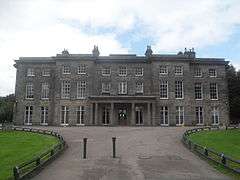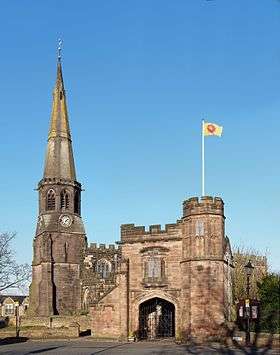Trencherfield Mill
Trencherfield Mill is a cotton spinning mill standing next to the Leeds and Liverpool Canal in Wigan, Greater Manchester, England. It was built in 1907. It was taken over by the Lancashire Cotton Corporation in the 1930s and passed to Courtaulds in 1964. The mill was driven by a 2,500 hp triple-expansion four-cylinder engine built by J & E Wood of Bolton in 1907. The two halves of the engine were called Rina and Helen. They drove a 26-foot flywheel with 54 ropes at 68 rpm. The engine was stopped in 1968.[2] The mill is now part of the Wigan Pier redevelopment area and is used for other purposes.
 Trencherfield mill, the working mill in 1951 | |
 Location within Greater Manchester | |
| Cotton | |
|---|---|
| Spinning (ring mill) | |
| Location | Wigan Pier |
| Serving canal | Leeds and Liverpool Canal |
| Further ownership |
|
| Coordinates | 53.5411°N 2.6378°W |
| Power | |
| Date | 1907 |
| Engine maker | J & E Wood |
| Decommissioned | Still in steam |
| Engine type | triple-expansion four-cylinder engine |
| Valve Gear | Corliss valves |
| rpm | 68 |
| Flywheel diameter | 26ft |
| Transmission type | ropes |
| No. of ropes | 54 |
| References | |
| [1] | |
Location

Wigan is a town in Greater Manchester, England.[3] It stands on the River Douglas which was canalised in the 1740s; 15 miles (24.1 km) south of Preston, 16.5 miles (26.6 km) west-northwest of Manchester, and 17.4 miles (28 km) east-northeast of Liverpool. Wigan is the largest settlement in the Metropolitan Borough of Wigan and is its administrative centre. Wigan is served by the Leeds and Liverpool Canal, the London and North Western Railway and the Lancashire and Yorkshire Railway. Trencherfield Mill stands by Wigan Pier, a wharf on the Leeds and Liverpool Canal, which was made famous by the writer George Orwell in his book, The Road to Wigan Pier. Orwell highlighted the poor working and living conditions of the local inhabitants during the 1930s.
History
Historically a part of Lancashire; during the Industrial Revolution Wigan experienced dramatic economic expansion and a rapid rise in the population. Although porcelain manufacture and clock making had been major industries in the town, Wigan has since become known as a major mill town and coal mining district.[4] The first coal mine was established at Wigan in 1450 and at its peak there were 1,000 pit shafts within 5 miles (8 km) of the town centre.[4] Mining was so extensive that one of its town councillors once remarked that "a coal mine in the backyard was not uncommon in Wigan".[5] Coal mining ceased during the latter part of the 20th century. In 1974, Wigan became a part of Greater Manchester.
Wigan's status as a centre for coal production, engineering and textiles in the 18th century led to the Douglas Navigation in the 1740s, the canalisation of part of the River Douglas, and later the diversion of the Leeds and Liverpool Canal in the 1790s at the request of the mill owners, to transport coal from the Lancashire coal pits to Wigan's mills and was also used extensively to transport local produce. As a mill town, Wigan was an important centre of textile manufacture during the Industrial Revolution; however it wasn't until the 1800s that cotton factories began to spread into the town. This was due to a dearth of fast-flowing streams and rivers in the area, but by 1818 there were eight cotton mills in the Wallgate part of Wigan.[6] In 1818 William Woods introduced the first power looms to the Wigan cotton mills.
Trencherfield Mill was built alongside the canal in 1907, for William Woods & Sons Ltd.[6]
The industry peaked in 1912, when it produced 8 billion yards of cloth. The Great War of 1914–18 halted the supply of raw cotton, and the British government encouraged its colonies to build mills to spin and weave cotton. The war over, Lancashire never regained its markets. The independent mills were struggling. The Bank of England set up the Lancashire Cotton Corporation in 1929 to attempt to rationalise and save the industry.[7] Trencherfield Mill was one of 104 mills bought by the LCC, and one of the 53 mills that survived through to 1950.
The semi derelict Grade II listed building was renovated between 2005-2007 as a key part of the Wigan Pier regeneration project, co-ordinated by Simon Kensdale. This project drew on a combination of European Regional Development Fund, Single Regeneration Budget and Heritage Lottery monies and it resulted in a number of sites in the Pier Quarter being restored to use. Trencherfield Mill itself became a mixed development comprising commercial, retail, and leisure space and 52 one and two-bedroom apartments. Wigan Council ultimately decided against establishing an arts centre - which would have included the town's first public theatre - within the Mill complex. However, the mill engine has been preserved, and restored. As of 2009 it can be seen in steam each Sunday morning. The mill is also used as a call centre for both EE and BT. Trencherfield Mill is also home to the prestigious Drama School: ALRA, The Academy of Live & Recorded Arts. www.alra.co.uk
Architecture
The original Trencherfield Mill was built in 1822–23 by William Woods. The present building dates from 1907, this was an early 20th-century mill. It had four-storeys and a basement; it was 31 by 6 bays. The chimney is circular.
Power

The mill was driven by a 2,500 hp triple-expansion four-cylinder steam engine by J & E Wood of Bolton built in 1907. The two halves of the engine are called Rina and Helen. They drive a 26-foot flywheel with 54 ropes at 68 rpm. The HP cylinders are steamed at 200psi. As a four-cylinder engine, it has two 44"LPs, a 40"IP, and 25"HP with a 5-foot stroke and has Corliss valves on all cylinders, Dobson block motion on HP and IP. The air pump is driven from each crosshead. It has a Lumb governor.[8]
The steam engine has been restored and operates as a visitor attraction. Engineers provide visitor tours on Sundays, and school and group visits are available during the week.
Owners
- Lancashire Cotton Corporation (1930s–1964)
- Courtaulds (1964–
See also
- Listed buildings in Wigan
- Textile manufacturing
- Cotton Mill
References
- LCC 1951
- Ashmore 1982, p. 147
- "Greater Manchester Gazetteer". Greater Manchester County Record Office. Place Names T to W. Archived from the original on 18 July 2011. Retrieved 9 July 2008.
- Frangoulp 1977, p. 139.
- The County Borough of Wigan: Official Handbook. Wigan County Borough Council. 1972.
- McNeil & Nevell 2000, p. 66.
- Dunkerley 2009
- Roberts 1921
Notes
Bibliography
- Ashmore, Owen (1982). The industrial archaeology of North-west England. Manchester University Press. ISBN 0-7190-0820-4. Retrieved 25 June 2009.
- Dunkerley, Philip (2009). "Dunkerley-Tuson Family Website, The Regent Cotton Mill, Failsworth". Archived from the original on 23 March 2008. Retrieved 9 January 2009.
- LCC (1951). The mills and organisation of the Lancashire Cotton Corporation Limited. Blackfriars House, Manchester: Lancashire Cotton Corporation Limited.
- Roberts, A S (1921), "Arthur Robert's Engine List", Arthur Roberts Black Book., One guy from Barlick-Book Transcription, archived from the original on 23 July 2011, retrieved 11 January 2009
External links
| Wikimedia Commons has media related to Trencherfield Mill, Wigan. |
- www.cottontown.org
- www.spinningtheweb.org.uk
- Trencherfield Mill Steam Engine – official site at Wigan Leisure & Culture Trust
- www.millatthepier.co.uk - Official website for The Mill at the Pier Venue based at Trencherfield Mill
- "Trencherfield Mill" Frank Wightman Manchester Archives+
- Lancashire Cotton Corporation Ltd. 1986, Frank Wightman Manchester Archives+


.jpg)

